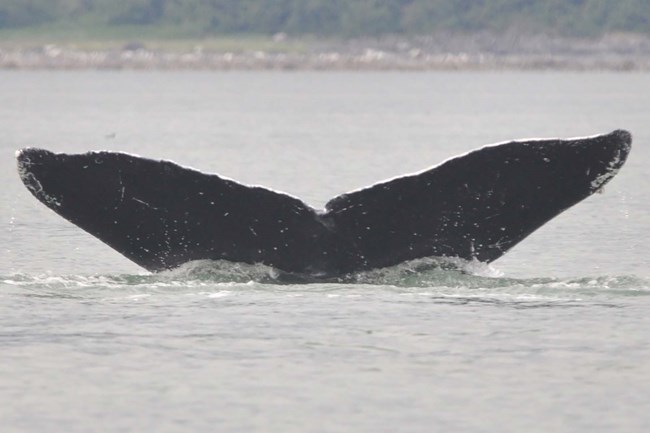Last updated: March 8, 2022
Article
Eulogy for a Whale - Festus (#441)

Glacier Bay National Park and Preserve lost a long-time resident. Festus, a male humpback whale, was found dead in the park waters in June 2016. He was in his mid-60s. His life story tells us what it’s like to be a whale in today’s changing oceans.
Researchers first saw Festus in Glacier Bay in 1972. He was listed in the Southeast Alaska catalog of humpback whale sightings as “#441” and nicknamed Festus because when Glacier Bay’s first whale researchers saw him in the Sitakaday Narrows he was “festooned” with kelp. Many researchers saw him over the years. In fact, he was regularly sighted over a period of 45 years, the longest sighting history of any humpback whale at the time. While humpback whales can live as long as 80-90 years, an average life span appears to be around 50.
Festus spent the winters in Hawaii and the summers in Alaska, making a seasonal round-trip migration of more than 5,000 miles. In Alaska, he was most often spotted in Glacier Bay and Icy Strait, but also frequented Frederick Sound, Seymour Canal, Lynn Canal, and Sitka Sound to take advantage of available food resources. In Hawaii, he was sighted off Maui in the mid-1980s and 1999, and off Kauai in 2004. He was sighted at least once in Hawaii escorting a female and calf.
Festus likely died from malnutrition and starvation. He was emaciated, his skin was in poor condition, and he was riddled with whale lice—indicating compromised immune system health. Tissue analyses of his internal organs revealed a variety of health conditions including multiple infections in his heart and lymph nodes. Low oil content in his blubber and a five-year stable-isotope dietary profile collected from his baleen showed extreme nutritional stress. Stress hormone (cortisol) data also suggest that Festus suffered prolonged, chronic stress since 2013 that peaked in late 2015 and early 2016, shortly before he died.
Unfortunately, Festus wasn’t the only whale casualty during this time. The North Pacific experienced the most extreme heatwave on record between 2014-2016 that profoundly impacted marine ecosystems. The Blob of unusually warm water was first detected in late 2013 and ocean temperatures peaked in 2015-2016. He was a statistic documented in the National Oceanic and Atmospheric Administration Department of Fisheries and Oceans 2015-2016 Large Whale Unusual Mortality Event. Between 2010 and 2014, the average annual number of humpback whale deaths was 13. But in 2015, 31 humpback whales died and another 19 died in 2016, including Festus. Long-term monitoring in Glacier Bay and Icy Strait also documented a population decline in humpback whales starting in 2014 and observed that 13-18% of whales were “skinny” with poor body condition over the next several years.
When Festus was found dead, there was no outward sign of serious injury—until we looked at his bones. Over the years, Glacier Bay whale monitoring photographs documented a large swelling on Festus’ left flank corresponding with Hawaii researchers’ failed satellite tag attachment in 1999. Post-mortem examination of Festus’ bones showed chronic osteomyelitis (inflammation of the bone). Over time, the bones deformed and likely impaired his mobility, another contributor to his decline in health. Tagging technology has since improved to help ensure whales don’t experience the kind of trauma Festus did.
Harmful algal blooms associated with marine heatwaves may also impact whale health. Festus had the neurotoxins domoic acid and saxitoxin in his body, indicating exposure to harmful algal blooms in the environment. We’re still learning about how much of these toxins it takes to cause health effects in whales.
Born around 1950, Festus experienced many changes in the ocean over his lifetime. He was in his youth during the commercial whaling era in the North Pacific that ended in 1966 for humpback whales. Humpback whales were among the first species designated as “endangered” in 1970. They were protected in 1972 under the Marine Mammal Protection Act and listed in 1973 under the Endangered Species Act.
His first three decades of life (1950-1980) were stable (relatively low stress and good nutrition), as determined from the lifetime hormone and isotope profile from his waxy ear plug. In the 1980s to early 1990s, variability in the carbon and nitrogen isotope signatures in his body reflect a shift in the marine ecosystem. The shift likely included a change in food sources. Isotope analyses showed the cyclic pattern of feeding in Alaska, fasting and breeding in Hawaii, and the regular stress of migration. The satellite tag injury in 1999 showed up as a peak in cortisol, a stress hormone. The analyses also noted a change in anthropogenic inputs, specifically exposure to fossil fuel carbon (the Exxon Valdez oil spill occurred in 1989, but the effect of hydrocarbons in the ocean is much broader).
Observing long-lived animals, like Festus the humpback whale, is valuable to learn about changing marine ecosystems. From his necropsy, we were able to learn more about how whales respond to various stressors. Stable isotope analyses and endocrine profiles told us what Festus was exposed to in the environment. Baleen and earplug profiles provided valuable physiological context for his life events. Bone pathology revealed the results of an injury that might have otherwise been overlooked. Through his death we can gain insight into environmental stressors in marine ecosystems.
Festus lived a long life. He was exposed to a number of conditions over time that, when combined, became too much, even for a great whale.
To read the full report about Festus’ life, death, and necropsy, see:
Gabriele, C. M., L. F. Taylor, K. B. Huntington, C. L. Buck, K. E. Hunt, K. A. Lefebvre, C. Lockyer, C. Lowe, J. R. Moran, A. Murphy, M. C. Rogers., S. J. Trumble, and S. Raverty. 2021. Humpback whale #441 (Festus): Life, death, necropsy, and research findings. Natural Resource Report NPS/GLBA/NRR—2021/2250. National Park Service, Fort Collins, Colorado. https://doi.org/10.36967/nrr-2285345.
